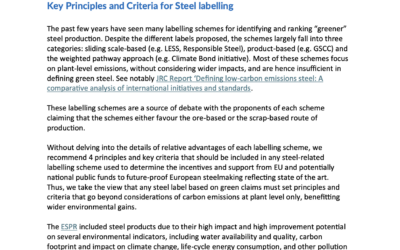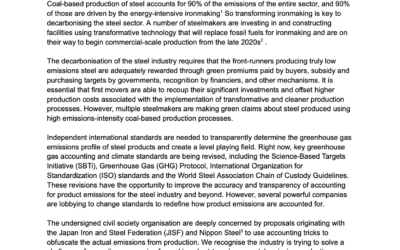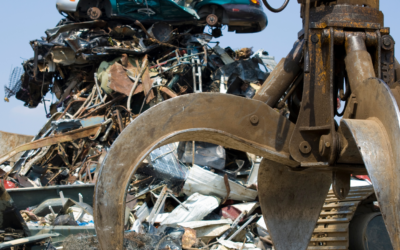CEPS-Sandbag Joint Op-Ed – The EU should lead the green steel race… Or it could be left behind in the dust
A wave of low-carbon steel projects should be launched across the EU by 2030 but how commercially viable they are is still to be seen. According to Agora Industry, two critical factors underpin this uncertainty: a carbon price below EUR 150 per tonne of CO2 emissions (currently it’s below EUR 60) and average electricity prices well above EUR 40/MWh. This constitutes a 20-50 % higher production cost for green steel (often called the green premium), compared to conventional steel.
Commercial viability is vital for attracting investment in greener technologies to replace or retrofit the EU’s blast furnace fleet. To address this, it’s imperative for the EU to develop downstream markets within the steel value chain that can absorb the green premium. While some EU companies from sectors such as construction, heating and cooling, automotive and white goods have committed to buying green steel, this demand is only a fraction of projected annual capacity by 2030.
However, there is currently no consolidated definition of what green steel actually is. Conflicting standards proposed by the steel industry have created a breeding ground for greenwashing and uncertainty about the true environmental performance of steel products. This is a chance for the EU to create clarity for all involved actors.
We need transitional regulatory measures to create lead markets for green steel to guarantee demand until the EU ETS and energy markets achieve cost parity between green and conventional steelmaking. The promise of a new EU industrial strategy – currently gathering pace under the Belgian Presidency to the Council – could be a golden opportunity to explore different possibilities.
Meanwhile, manufacturers further down the value chain face challenges in passing on these additional costs to consumers, who may not be willing to pay more for identical products that offer no additional benefits beyond their environmental credentials.
According to Sandbag’s latest report, to minimise the impact on consumers and to de-risk investments targeted towards the most carbon-intensive steel production, lead markets should focus on manufacturing sectors that consume significant amounts of flat steel and whose final products have lower procurement costs as a proportion of their retail price.
Cars as a lead market for green steel
A recent CEPS report shows that it’s the automotive industry that could really steer the demand for green steel. It’s the biggest steel-consuming sector after construction, accounting for around 12 % of global steel consumption. Carmakers can potentially pass the cost of the ‘green premium’ on to end consumers, much easier than construction. Research estimates that a vehicle’s final price would actually only increase by 0.5 to 2 %.
Still, why would carmakers willingly switch to greener steel? With transport’s continued electrification, the emissions embedded in vehicles’ materials (like steel) become increasingly important compared to ‘tailpipe’ emissions. Material emissions make up 23 % of internal combustion engine and 42 % of electric vehicles in the current energy mix. If carmakers want to reduce these, buying greener steel would be a good way to go.
But such voluntary commitments don’t guarantee greater demand for green steel and wouldn’t create investment security for steelmakers. We need additional incentives – and here policymakers can make all the difference.
The devil is in the policy detail
EU policies for decarbonising transport mainly focus on reducing tailpipe emissions. But policymakers can’t rest on their laurels. Policies to strengthen sustainability transparency (e.g. the Corporate Sustainability Reporting Directive or the proposed Green Claims Directive) can support more informed consumer choice when it comes to buying (cars containing) low-emissions steel. However, these are rather indirect measures and no surefire way to stimulate demand.
What really could drive change are clear and measurable targets. The EU could make vehicle manufacturers introduce a gradually increasing minimum share of green steel, or a gradually decreasing maximum carbon footprint. Different policy options could feature such a target, including the proposed End-of-Life Vehicles Regulation, the proposed Ecodesign for Sustainable Products Regulation, an update of existing vehicle standards, or even Green Public Procurement.
However it’s done, a common definition and standard for green steel is a prerequisite.
Careful policy design shouldn’t deter ambitious targets
Such a target wouldn’t be without pitfalls. Mandating green steel may incentivise carmakers to switch to alternatives, for example, aluminium for certain components, thus still achieving the necessary emissions reductions. Yet it’s clear that such a target would be the best bet to stimulate demand, allowing the steel industry to invest and over time switch to more sustainable production methods.
While getting there may be daunting, policymakers shouldn’t shy away from taking the hard decisions required – bold ambitions are needed. If we want an automotive lead market for green steel, then setting a target will be the best way to do so.
Written by Patricia Urban (Researcher, CEPS) and Fausto Zaccaro (Policy Officer, Sandbag).
Photo by [anonymous] on Unsplash
Read More:
New Principles for Steel Labelling: response to the consultation on the Industrial Decarbonisation Accelerator Act
Sandbag’s response to the EU’s Industrial Decarbonisation Accelerator Act sets out four principles to guide green steel labelling schemes, promoting credible standards based on lifecycle emissions and system-wide decarbonisation.
Steel emissions standards under threat from flawed “mass balance” proposal
A joint letter from 30+ NGOs warns that coal-based steel could be falsely labelled as green under proposed “mass balance” rules. The signatories call for traceable, credible emissions data in steel standards.
Joint statement urges EU to boost the use of recycled steel scrap in the automotive sector
A new joint statement urges the EU to set binding targets for recycled steel use in cars, citing the climate benefits of secondary steel and the need to reduce demand for high-emission imports.



